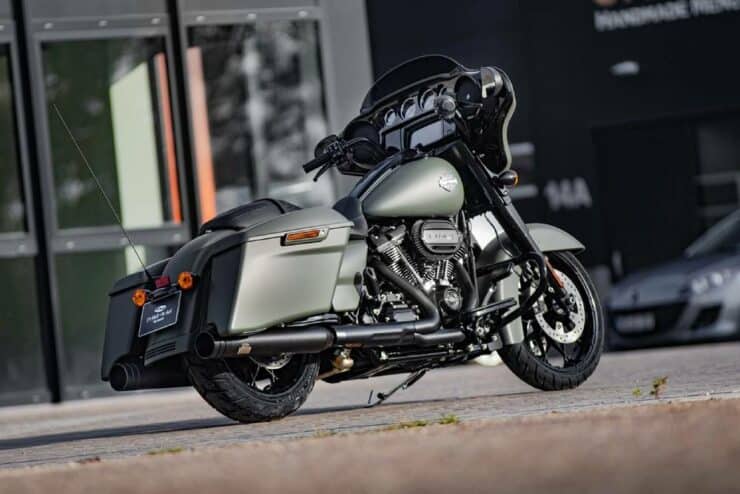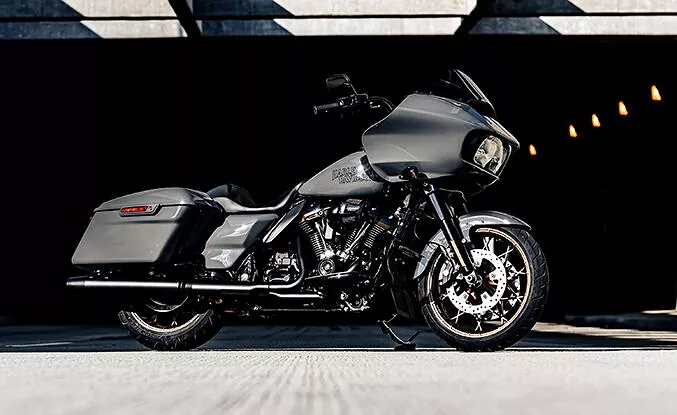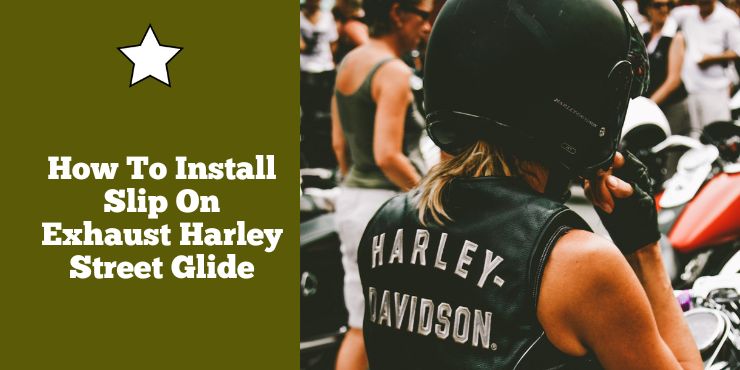If you’re an avid Harley Street Glide rider looking to customize your ride and improve performance, a slip on exhaust is a great choice. Installing a slip on exhaust is a relatively easy process that can provide both aesthetic and performance benefits.
To install slip-on exhausts, remove the stock mufflers by loosening the clamps and bolts. Slide the new slip-on mufflers onto the exhaust pipes, align them, and tighten the clamps and bolts securely.
In this article, we’ll walk you through a step-by-step guide on how to easily install a slip on exhaust on a Harley Street Glide, so you can get the most out of your ride. So if you’re ready to get started, read on and see how you can easily improve your Harley Street Glide with a slip on exhaust.
Slip-on exhaust on a Harley-Davidson Street Glide
The Harley-Davidson Street Glide is an iconic bike known for its powerful engine, iconic design, and thunderous exhaust note. One way of enhancing the performance and sound of this powerful machine is by installing a slip-on exhaust system. A slip-on exhaust will offer a variety of benefits, from improved horsepower and torque to a more aggressive and throaty sound.
A slip-on exhaust is essentially an aftermarket component that replaces the stock mufflers on a Harley-Davidson motorcycle. It is designed to be a direct bolt-on replacement, making it quite easy to install. Slip-on exhausts are a popular option among Harley-Davidson bikers who wish to enhance the performance and sound of their bikes without making extensive modifications.
Why do bikers opt for slip-on exhausts?
One of the reasons many bikers opt for slip-on exhaust systems is to improve the performance of their Harley-Davidson Street Glide. By reducing backpressure and improving exhaust flow, slip-on exhausts will increase horsepower and torque. The improved exhaust flow will allow the engine to breathe more freely, which results in better throttle response and overall performance. While the gains might not be as significant as with a full exhaust system, slip-on exhausts will still provide noticeable improvements.

The sound of a Harley-Davidson Street Glide is an integral part of the riding experience and slip-on exhausts deliver an enhanced auditory sensation. These aftermarket systems produce a deeper, richer, and more aggressive exhaust note compared to the stock mufflers. The sound can vary depending on the specific slip-on exhaust chosen, with the options ranging from a classic rumble to a more aggressive roar. It is important that you consider local noise regulations when choosing a slip-on exhaust to ensure you’re complying with legal requirements.
Aside from the performance and sound benefits, slip-on exhaust systems offer different customization options for the appearance of the Harley-Davidson Street Glide. Many aftermarket manufacturers offer a wide range of slip-on exhaust designs, including various finishes, shapes, and tip styles. This will allow the rider to personalize their motorcycles and give them a unique look that matches their style and preferences. Whether you’re going for a chrome finish, a blacked-out look, or a specific design, there are more than enough options to choose from.
Another reason why slip-on exhausts are often adored by Street Glide bikers is their ease of installation. Unlike a full exhaust system, which requires more extensive modifications and adjustments, slip-on exhausts can be installed easily using basic tools and minimal mechanical knowledge. They’re designed to fit directly onto the stock headers, making the installation process rather straightforward for most riders.
Precautions when installing a slip-on exhaust system
Before you purchase and install a slip-on exhaust system, there are a few factors that you should consider. First, you must ensure that the slip-on exhaust you’ve chosen is compatible with your specific model and year of the Harley-Davidson Street Glide. You must double-check the manufacturer’s specifications to ensure a proper fit.
It is essential that you consider potential warranty implications. Modifying the exhaust system of your bike might void the manufacturer’s warranty, so you should be sure that you understand the terms and conditions before you make any changes.
You must also be mindful of local noise regulations and legal requirements. Some slip-on exhaust systems might produce sound levels that exceed local noise limits. It is important that you research and select a slip-on exhaust that complies with the noise regulations in your area to avoid any legal issues.
Required tools and materials for installing a slip-on exhaust
If you are looking to install a slip-on exhaust on your Harley-Davidson Street Glide, it’ll be important to gather the right tools and materials for a successful installation. Whether you are upgrading the exhaust system for performance gains, sound enhancement, or aesthetic customization, there are certain tools you will require. These tools and materials will help you ensure a smooth and safe installation process.
#1. A new slip-on exhaust system
You should choose a slip-on exhaust that is specifically designed for your Street Glide’s model and year. There are different aftermarket options available so you should ensure that you select one that meets your preferences and requirements.
#2. A socket set
A comprehensive socket set with various socket sizes is required for loosening and tightening nuts and bolts during the installation process. Opt for a high-quality set that includes both metric and standard sizes for covering all your needs.
#3. Torque wrench
A torque wrench will be a crucial tool to ensure that you tighten the exhaust components to the manufacturer’s specified torque settings. This will help in preventing overtightening, which can result in damage or undertightening, which can cause leaks.
#4. Allen wrench set
Slip-on exhaust systems typically use Allen bolts for installation. Having a set of Allen wrenches or a multi-tool with Allen wrench attachments will allow you to securely fasten these bolts.
#5. Screwdrivers
A set of Phillips and flathead screwdrivers might come in handy for certain aspects of the installation, such as removing any screws or clips securing the stock mufflers or heat shields.
#6. Lift or jack
While not strictly necessary, having access to a lift or a motorcycle jack can simplify the installation process significantly. It’ll allow you to raise the motorcycle, offering easier access to the exhaust components and making the installation safer and more convenient. If you don’t have access to a lift or jack, you can make use of a sturdy and stable surface to support your bike securely.
#7. Penetrating oil
In certain cases, the stock exhaust components might be rusted or tightly secured. Applying penetrating oil to the fasteners beforehand will help loosen them, making removal easier and minimizing the risk of stripping or breaking bolts.
#8. Threadlocker
It is recommended that you should use threadlocker when installing the new slip-on exhaust components. Threadlocker will help prevent nuts and bolts from loosening due to vibrations. Make sure that you select the appropriate strength of threadlocker for your application.
#9. Protective gear
When working on your bike, it is crucial to prioritize safety. You must wear appropriate protective gear, including gloves, ear protection, and safety goggles. Gloves will protect your hands from cuts, burns, and other potential injuries. Safety glasses will shield your eyes from dust and debris whereas ear protection will reduce the risk of hearing damage caused by loud noises during the installation.
#10. Owner’s manual
You must refer to the owner’s manual of your bike for specific instructions and guidelines regarding the exhaust system. Moreover, you should carefully read and follow the manufacturer’s instructions offered with the slip-on exhaust system to ensure a proper and safe installation.

How to remove the existing exhaust
When it comes to installing a slip-on exhaust on your Street Glide, one of the initial steps will be to first remove the existing exhaust. This process will typically involve removing the heat shields, unbolting the exhaust components, and lastly removing the exhaust itself. Here are the steps that you will need to carry out to navigate through this part of the installation safely and smoothly.
Step 1: Arm yourself with the necessary tools and materials
Before you start, you must gather the necessary tools and materials needed for the task. You must refer to the previous section to ensure you have all the appropriate tools, such as a socket set, Allen wrenches, screwdrivers, a torque wrench, and other specific tools mentioned in your bike’s owner’s manual.
Additionally, you should prioritize your safety by putting on protective gear. Safety glasses, gloves, and ear protection should be worn to safeguard against potential injuries and hazards.
Step 2: Consult the owner’s manual and exhaust system instructions
Review your Street Glide’s owner’s manual for specific instructions related to the exhaust removal process. It is important that you familiarize yourself with the manufacturer’s guidelines and recommendations. Moreover, you should refer to the instructions provided with the slip-on exhaust system for any specific details or variations.
Step 3: Let the exhaust cool down
If your motorcycle has been ridden recently, the exhaust components might be hot. It is important that you allow them to cool down before you attempt to remove them to avoid burns. Exercise caution and patience during this step.
Step 4: Remove the heat shields
Many stock exhaust systems come with heat shields that offer protection and aesthetics. Start by locating and removing the bolts or clamps that secure the heat shields. Depending on your Street Glide’s year, you might have to use a socket set or Allen wrenches for this task. You must carefully set aside the heat shields, making sure that you don’t damage them during the removal process.
Step 5: Loosen the bolts and nuts
Next up, you should locate and loosen the bolts and nuts that secure the exhaust components to your bike. These fasteners might be situated at various points alongside the exhaust system, such as where it connects to the headers or mounting brackets. Make use of appropriate tools such as Allen wrenches or a socket set for loosening the fasteners. However, avoid removing them completely at this stage.
Once the fasteners have been loosened, it’ll be crucial that you provide adequate support to prevent the exhaust system from falling or putting unnecessary strain on other components. Depending on the setup, you’ll be able to use a motorcycle lift or a jack or have an assistant support the exhaust while you continue with the removal.
Step 6: Remove the exhaust components
With the exhaust system properly supported, you must remove the remaining bolts and nuts. This will allow you to detach the exhaust components from the bike. Carefully slide the components out, one by one, ensuring that you don’t damage any surrounding parts or wiring during the process. Take notes of any seals or gaskets that might be present as they might have to be replaced during the installation of the new slip-on exhaust.
That’s it, you have removed the exhaust from your Street Glide. Remember that you should keep all the removed components, nuts, and bolts in a safe place as you might require them later for reference or reinstallation.

How to install slip-on exhaust Harley Street Glide
Once you have managed to remove the existing exhaust system on your Harley-Davidson Street Glide, you are in the right position to install a new slip-on exhaust. As long as you know the right instructions and you have the necessary tools and materials, you will be able to install it within a matter of minutes.
Step 1: Read the exhaust system’s instructions
You must carefully read and understand the instructions provided with the new slip-on exhaust system. Each exhaust system might come with specific guidelines and variations. This is why it is essential that you follow the manufacturer’s recommendations for a simple and proper installation.
Step 2: Align the slip-on exhaust
Position the new slip-on exhaust components in place and align them with the mounting points on your Harley-Davidson Street Glide. Then, you should loosely attach the mounting brackets or clamps provided with the exhaust system. This will allow you to make adjustments and ensure proper alignment before final tightening.
Step 3: Secure the exhaust components
With the slip-on exhaust aligned, you must proceed to tighten the mounting brackets or clamps. Gradually tighten the nuts and bolts, alternating between sides to maintain an even pressure. Make use of a torque wrench for ensuring that you tighten the fasteners to the manufacturer’s specified torque settings. This step will be important for both proper alignment and preventing the exhaust from coming loose during operation.
Step 4: Reinstall the heat shields
If the slip-on exhaust system includes heat shields or if you’re reinstalling the original heat shields, you must carefully position them over the slip-on exhaust. Align the mounting holes on the heat shields with the corresponding holes or brackets on the Street Glide’s frame or exhaust components. Make use of the appropriate bolts or clamps to secure the heat shields in place. You must make sure that you’re tightening the fasteners to the specified torque settings.
Step 5: Perform a final torque check
Once all the components have been secured in place, you must perform a final torque check on all the fasteners, including the slip-on exhaust mounting brackets, heat shield fasteners, and any other relevant bolts or nuts. Make use of a torque wrench for ensuring that they are tightened to the manufacturer’s specifications. This step will be important for safety as it will prevent any issues caused by loose connections.
Step 6: Double-check alignment and clearance
After the final torque check, you must take a step back and visually inspect the slip-on exhaust system. You must make sure that it is properly aligned, parallel to the motorcycle frame, and that there is sufficient clearance from other parts such as saddlebags, rear tires, and suspension components. You must make any necessary adjustments to make sure you get a proper fit and clearance.
You have installed the slip-on exhaust system on your Harley-Davidson Street Glide. At this point, it is advised that you should start your bike and let it run for a couple of minutes to ensure there are no exhaust leaks or unusual sounds. If you’re noticing any issues, you must promptly address them by rechecking the alignment and fasteners. Dispose of any unwanted materials. Enjoy the enhanced performance, sound, and visual appeal that the new slip-on exhaust system will bring to your Harley-Davidson Street Glide. Remember to ride responsibly while still adhering to local noise regulations and legal requirements.
Cleaning and testing after installing the new slip-on exhaust
Once you have successfully installed a new slip-on exhaust system on your Harley-Davidson Street Glide, it’ll be important that you carry out a few final steps. You will need to clean up any mess you’ve made and ensure that everything is working as intended before you take your Street Glide out for a test ride. Here, you will get to know the process of cleaning up and testing your bike so that you can enjoy driving your Street Glide with the new exhaust.
Step 1: Clean up the work area
Before you start your Street Glide, you must take a moment or two to clean up your work area. Remove any tools, debris, or packaging material that might have accumulated during the installation process. This will help prevent any loose items from interfering with the motorcycle’s operation and ensure a clean and safe environment.
Step 2: Inspect for any loose fasteners or leaks
Once the work area has been cleaned, you should conduct a visual inspection of the slip-on exhaust system. Check the fasteners, including the mounting brackets, heat shield bolts, and other connections to make sure that they are properly tightened and secure. Pay close attention to the slip-on exhaust joints and connections. Look for any signs of leaks or abnormal gaps. If you notice any issues, you should address them promptly before you proceed.
Step 3: Start the motorcycle and listen for any abnormal sounds
Once the visual inspection is complete, you should start your Harley-Davidson Street Glide and let it idle for a couple of minutes. Carefully, listen for any unusual sounds, rattles, or vibrations that might indicate an installation issue or exhaust leak. If you notice anything concerning, you must turn off the motorcycle and investigate further. Check the alignment, tightness of the connections, and gaskets/seals for proper seating. Address any issues before you move forward.
Step 4: Go on a short ride
Assuming everything looks and sounds good during the idle phase, it’ll be time to take your bike for a short test ride. Start off by riding at a moderate pace in a controlled environment, such as a quiet road or parking lot. Pay close attention to how the bike responds to the throttle, any changes in sound or performance, and the overall riding experience with the new slip-on exhaust. It is normal to notice a difference in exhaust notes and potentially a small increase in the performance because of improved exhaust flow.
Step 5: Monitor for proper performance and behavior
During the test ride, you must observe the bike’s performance and behavior. Pay close attention to the throttle response, acceleration, and braking. Make sure that the slip-on exhaust isn’t interfering with any other components, such as saddlebags or rear suspension. Monitor the engine temperature and check for any warning lights or abnormal readings on the instrument cluster. If you notice any problems or concerns, you should return home and address them before you go on a long ride.
Step 6: Fine-tune and enjoy
Once you have completed the initial test ride, you must return home and fine-tune any adjustments if needed. This might include realigning the slip-on exhaust system, tightening any loose fasteners, or addressing minor issues that arose during the test ride. Make sure that you follow the manufacturer’s instructions for any specific adjustments or maintenance recommended for your slip-on exhaust system.
FAQs
What tools are needed to install a slip on exhaust on a Harley Street Glide?
To install a slip on exhaust on a Harley Street Glide, you will need a variety of tools, including a socket set, screwdrivers, and wrenches. You may also need specialty tools such as a torque wrench, exhaust pipe cutter, and/or exhaust clamps. It’s important to ensure you have all the necessary tools before beginning the installation process.
What is the process for installing a slip on exhaust on a Harley Street Glide?
The process for installing a slip on exhaust on a Harley Street Glide involves several steps, including removing the existing exhaust, preparing the new exhaust, and mounting the new exhaust. It is important to follow the manufacturer’s instructions carefully to ensure the installation is done correctly.
What should I do if I have difficulty installing a slip on exhaust on a Harley Street Glide?
If you are having difficulty installing a slip on exhaust on a Harley Street Glide, it is best to seek the help of a professional. A qualified mechanic should be able to help you with the installation process, ensuring it is done correctly and safely.

